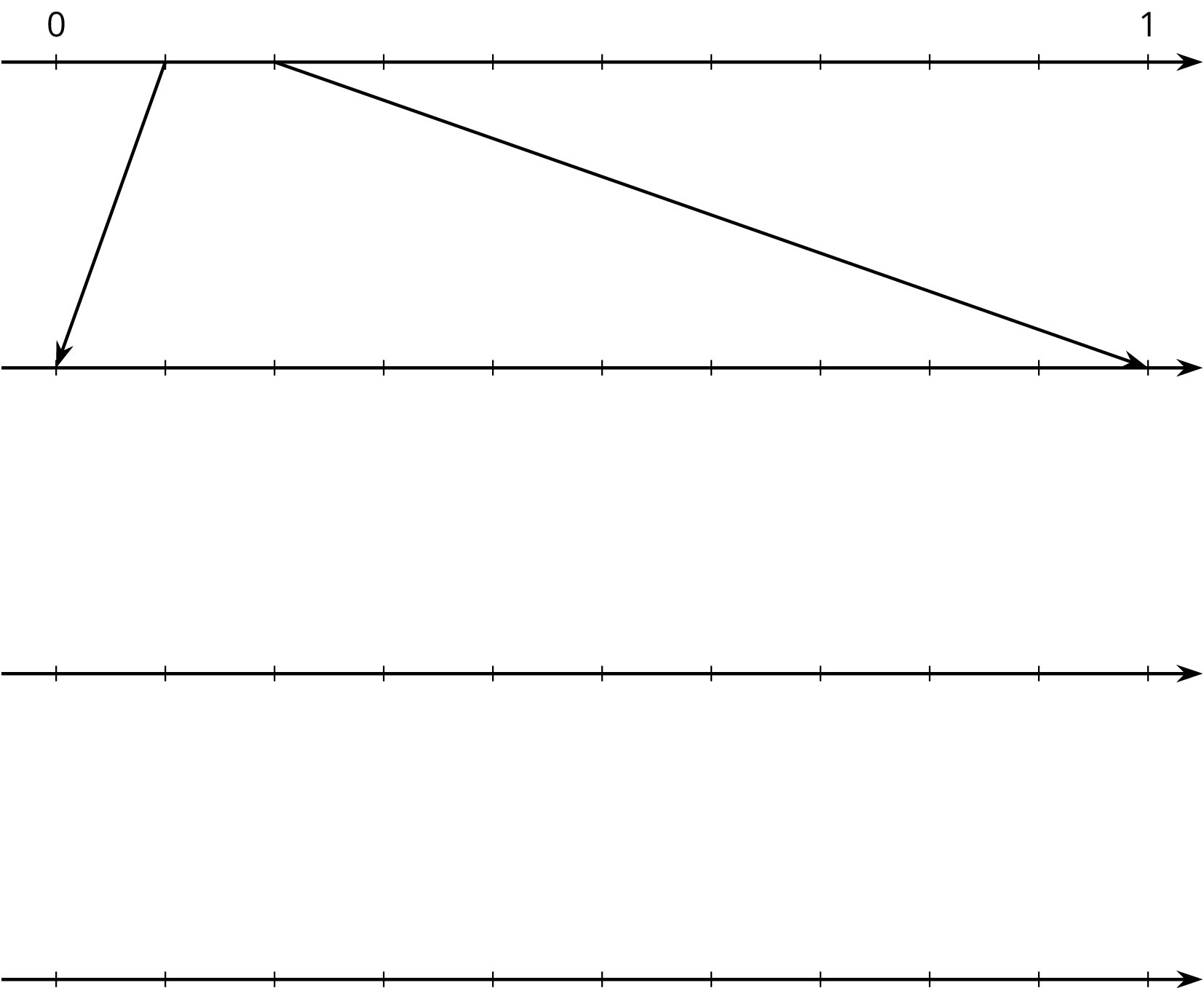Lesson 14
Decimal Representations of Rational Numbers
14.1: Notice and Wonder: Shaded Bars (5 minutes)
Warm-up
The purpose of this warm-up is for students to review what rational numbers are—fractions and their opposites. In earlier lessons, students explored square and cube roots and now return to strictly rational numbers. While students do not need to be able to recite a definition for rational numbers, this type of diagram is one students are likely familiar with and gives students an opportunity to use related language such as part, whole, halves, 1 out of 8 parts, one eighth, etc. After students work with different representations of rational numbers in upcoming lessons, they will expand their definition and understanding of irrational numbers.
Launch
Arrange students in groups of 2. Tell students that they will look at an image, and their job is to think of at least one thing they notice and at least one thing they wonder. Display the image for all to see. Ask students to give a signal when they have noticed or wondered about something. Give students 1 minute of quiet think time, and then 1 minute to discuss the things they notice with their partner, followed by a whole-class discussion.
Student Facing
What do you notice? What do you wonder?

Student Response
For access, consult one of our IM Certified Partners.
Activity Synthesis
Ask students to share the things they noticed and wondered. Record and display their responses for all to see. If possible, record the relevant reasoning on or near the image. After each response, ask the class if they agree or disagree and to explain alternative ways of thinking, referring back to the images each time.
14.2: Halving the Length (10 minutes)
Optional activity
The purpose of this optional activity is for students to see what the figure in the warm up didn’t explore: as 1 is successively divided in half, the number of digits needed to accurately describe the resulting value increases. Students likely have memorized that a half is 0.5 and a fourth is 0.25, but what is half of 0.25? How can you calculate it? Use this activity if you think your students need a reminder about place value or long division with decimals.
Launch
Do not provide access to calculators. Give students 2 minutes quiet work time followed by partner then whole-class discussion.
Design Principle(s): Optimize output (for generalization)
Student Facing
Here is a number line from 0 to 1.

- Mark the midpoint between 0 and 1. What is the decimal representation of that number?
- Mark the midpoint between 0 and the newest point. What is the decimal representation of that number?
- Repeat step two. How did you find the value of this number?
- Describe how the value of the midpoints you have added to the number line keep changing as you find more. How do the decimal representations change?
Student Response
For access, consult one of our IM Certified Partners.
Activity Synthesis
Discuss:
- “How can you use long division to answer the third problem?”
- “What are these values when written in fraction notation? How do you know?”
Supports accessibility for: Memory; Language
14.3: Recalculating Rational Numbers (20 minutes)
Activity
The purpose of this task is for students to rewrite rational numbers with terminating decimal expansions in fraction form and fractions with terminating decimal expansions as decimals. This activity is the first of a series of three in which students rewrite numbers in different ways, supporting their understanding of what rational and irrational numbers are and how they can be represented.
Monitor for students who write \(\frac15\) and \(\frac{2}{10}\) for 0.2.
Launch
Arrange students in groups of 2. Do not provide access to calculators.
Remind students that all rational numbers are fractions and their opposites, and they can all be written in the form \(\frac{a}{b}\) where \(a\) and \(b\) are integers (with \(b\neq 0\)). In fact, there are many equivalent fractions that represent a single rational number. For example, 5 is equivalent to \(\frac{10}{2}\) and \(\frac{15}{3}\).
Students should complete the problems individually, then compare with their partners and come to resolutions over any differences. Repeat this process for the second problem.
Supports accessibility for: Memory; Organization
Design Principle(s): Maximize meta-awareness
Student Facing
-
Rational numbers are fractions and their opposites. All of these numbers are rational numbers. Show that they are rational by writing them in the form \(\frac{a}{b}\) or \(\text -\frac{a}{b}\).
- 0.2
- \(\text -\sqrt{4}\)
- 0.333
- \(\sqrt[3]{1000}\)
- -1.000001
-
\(\sqrt{\frac19}\)
-
All rational numbers have decimal representations, too. Find the decimal representation of each of these rational numbers.
- \(\frac38\)
- \(\frac75\)
- \(\frac{999}{1000}\)
- \(\frac{111}{2}\)
- \(\sqrt[3]{\frac18}\)
Student Response
For access, consult one of our IM Certified Partners.
Anticipated Misconceptions
Some students may write that \(0.333=\frac13\). If so, ask them to check their work by calculating the decimal representation of \(\frac13\).
Activity Synthesis
The purpose of this discussion is to highlight different strategies for rewriting rational numbers in different forms. Select previously identified students to share their solutions, including one student who wrote \(\frac15\) for 0.2 and another who wrote \(\frac{2}{10}\). For the problems with roots, the values were purposefully chosen to emphasize to students that just because a number is written with a square or cube root does not mean it is not rational.
For 0.2, draw a number line with the numbers 0, 1, and 2 with plenty of space between the integers. Subdivide the segment from 0 to 1 into 5 equal pieces, and then ask where to plot \(\frac15\). Then label \(\frac15\) and ask how we can see that this is \(\frac{2}{10}\). (Subdivide each fifth into two equal pieces—now each one is \(\frac{1}{10}\).) Then label the point \(\frac{2}{10}\) and 0.2.

Remind students that the point corresponds to a rational number, and we have a lot of different ways we can represent that number.
14.4: Zooming In On $\frac{2}{11}$ (10 minutes)
Activity
This activity continues with the work from the previous activity by examining a decimal representation of a rational number that, when written as a decimal, repeats forever. The purpose of this activity is for students to use repeated reasoning with division to justify to themselves that \(0.1818 . . .\) repeats the digits 1 and 8 forever (MP8).
Launch
Arrange students in groups of 2. Do not provide access to calculators. Tell students that now we are going to think about the decimal representation of \(\frac{2}{11}\). Remind students that they should be prepared to explain their reasoning for each step in the activity.
If you think students need a reminder of how the zooming number lines work, which were used in an earlier unit, demonstrate how to show where \(\frac{1}{8}\) is using 3 number lines, starting with one from 0 to 1.
Students in groups of 2. Give 2 minutes for students to begin individually and then ask students to discuss their work with their partner and resolve any differences. Follow with a whole-class discussion.
Supports accessibility for: Conceptual processing; Visual-spatial processing
Student Facing

-
On the topmost number line, label the tick marks. Next, find the first decimal place of \(\frac{2}{11}\) using long division and estimate where \(\frac{2}{11}\) should be placed on the top number line.
-
Label the tick marks of the second number line. Find the next decimal place of \(\frac{2}{11}\) by continuing the long division and estimate where \(\frac{2}{11}\) should be placed on the second number line. Add arrows from the second to the third number line to zoom in on the location of \(\frac{2}{11}\).
-
Repeat the earlier step for the remaining number lines.
- What do you think the decimal expansion of \(\frac{2}{11}\) is?
Student Response
For access, consult one of our IM Certified Partners.
Student Facing
Are you ready for more?
Let \(x=\frac{25}{11}=2.272727. . . \) and \(y=\frac{58}{33}=1.75757575. . .\)
For each of the following questions, first decide whether the fraction or decimal representations of the numbers are more helpful to answer the question, and then find the answer.
- Which of \(x\) or \(y\) is closer to 2?
-
Find \(x^2\).
Student Response
For access, consult one of our IM Certified Partners.
Activity Synthesis
The purpose of this discussion is to explicitly state the repeated reasoning and successive approximation used to calculate each digit after the decimal point for \(\frac{2}{11}\). Select one or two students to share their reasoning about the decimal representation of \(\frac{2}{11}\).
Tell students that we often find that the decimal representation of a rational number repeats like this, and we have a special notation to represent it. Then write
\(\displaystyle 0.18181818181818181818 . . . = 0.\overline{18}\)
Lesson Synthesis
Lesson Synthesis
This lesson was about rational numbers and their decimal representations.
- “What is a rational number?” (A fraction (or its equivalent) or its opposite.)
- “What do we know about the decimal expansion of rational numbers?” (The decimal expansion always eventually repeats. Sometime the repeating part is zeros, like 0.250000 . . . in which case we can also say it terminates.)
14.5: Cool-down - An Unknown Rational Number (5 minutes)
Cool-Down
For access, consult one of our IM Certified Partners.
Student Lesson Summary
Student Facing
We learned earlier that rational numbers are a fraction or the opposite of a fraction. For example, \(\frac34\) and \(\text-\frac52\) are both rational numbers. A complicated-looking numerical expression can also be a rational number as long as the value of the expression is a positive or negative fraction. For example, \(\sqrt{64}\) and \(\text-\sqrt[3]{\frac18}\) are rational numbers because \(\sqrt{64} = 8\) and \(\text-\sqrt[3]{\frac18} = \text-\frac12\).
Rational numbers can also be written using decimal notation. Some have finite decimal expansions, like 0.75, -2.5, or -0.5. Other rational numbers have infinite decimal expansions, like 0.7434343 . . . where the 43s repeat forever. To avoid writing the repeating part over and over, we use the notation \(0.7\overline{43}\) for this number. The bar over part of the expansion tells us the part which is to repeat forever.
A decimal expansion of a number helps us plot it accurately on a number line divided into tenths. For example, \(0.7\overline{43}\) should be between 0.7 and 0.8. Each further decimal digit increases the accuracy of our plotting. For example, the number \(0.7\overline{43}\) is between 0.743 and 0.744.